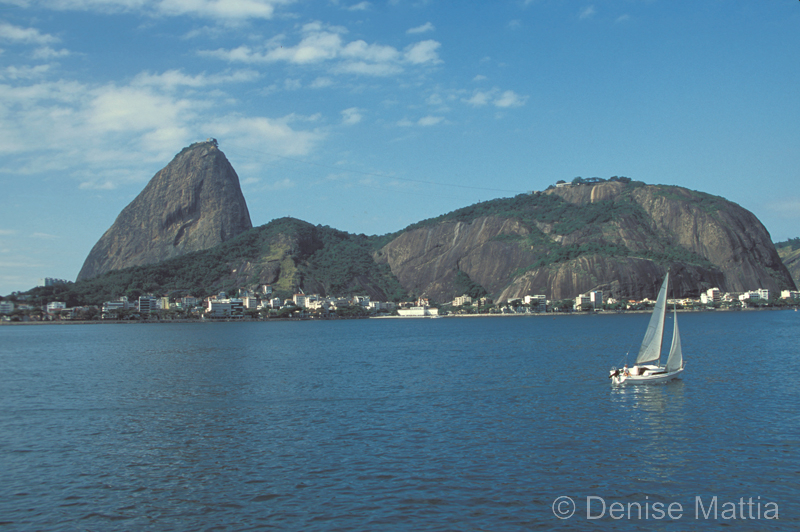
By Denise Mattia
 It was hard not to be smug while I sat by a pool and watched others exercise to Samba rhythms in it. Uniformed people kept coming up to me and asking if senhora would like . . .? Another delicious and potent caipirinha, a blend of lime, ice and cachaça, what the Brazilians call distilled sugarcane, appeared. Ooobrigado very much, indeed. Maybe Senhora could get used to this.
It was hard not to be smug while I sat by a pool and watched others exercise to Samba rhythms in it. Uniformed people kept coming up to me and asking if senhora would like . . .? Another delicious and potent caipirinha, a blend of lime, ice and cachaça, what the Brazilians call distilled sugarcane, appeared. Ooobrigado very much, indeed. Maybe Senhora could get used to this.
Nearly three weeks before being driven in air-conditioned comfort from the airport to the manicured boundaries of Bahia’s Costa do Sauípe, I had set out from New York on an odyssey that would ultimately cover 4500 miles of Brazilian territory and would include a variety of the country’s scuba sites.
It was typical winter when I arrived in Rio de Janeiro – seductively sunny and warm – yet from the onset my dive 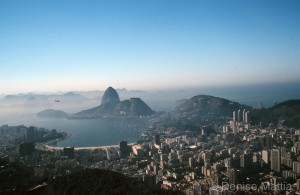 plans were scratched. High winds in the Atlantic prevented small craft from leaving the marina. I suffered the city’s legendary beaches, sights and cafes and, by the evening of the fourth day, was on the verge of becoming a native carioca. Still, there’s nothing sadder than the sight of a dry scuba bag in the corner of a room. I tucked away the brochures and flew west to Campo Grande in the state of Mato Grosso do Sul.
plans were scratched. High winds in the Atlantic prevented small craft from leaving the marina. I suffered the city’s legendary beaches, sights and cafes and, by the evening of the fourth day, was on the verge of becoming a native carioca. Still, there’s nothing sadder than the sight of a dry scuba bag in the corner of a room. I tucked away the brochures and flew west to Campo Grande in the state of Mato Grosso do Sul.
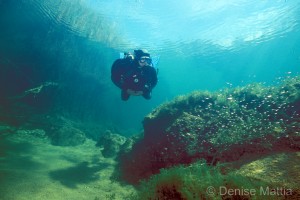 I em- braced (a Brazilian custom I’d adopted) my old friend, Ismael, when we met at the airport. Gear loaded in our rented car, we roared away on the road – there’s only one – to Bonito, where I would be diving in fresh-water rivers and caverns. There were plenty of reasons to stop during our four-hour journey; the late afternoon sun accented the rich, rolling plains of cattle country and called for a camera.
I em- braced (a Brazilian custom I’d adopted) my old friend, Ismael, when we met at the airport. Gear loaded in our rented car, we roared away on the road – there’s only one – to Bonito, where I would be diving in fresh-water rivers and caverns. There were plenty of reasons to stop during our four-hour journey; the late afternoon sun accented the rich, rolling plains of cattle country and called for a camera.
Bonito is a little town of one-story buildings that boasts fewer people than the number of small hotels and guesthouses in the community and surrounding perimeter combined. Tour groups are lodged in these for a night and then continue on by the busload to the Pantanal. Ismael deposited my luggage at the gates of Pousada Segredo, a basic B & B, and we drove to a clearing for a spectacular sunset. The temperature dropped to 40˚ and the thought of diving in frigid water sent a shiver through me. 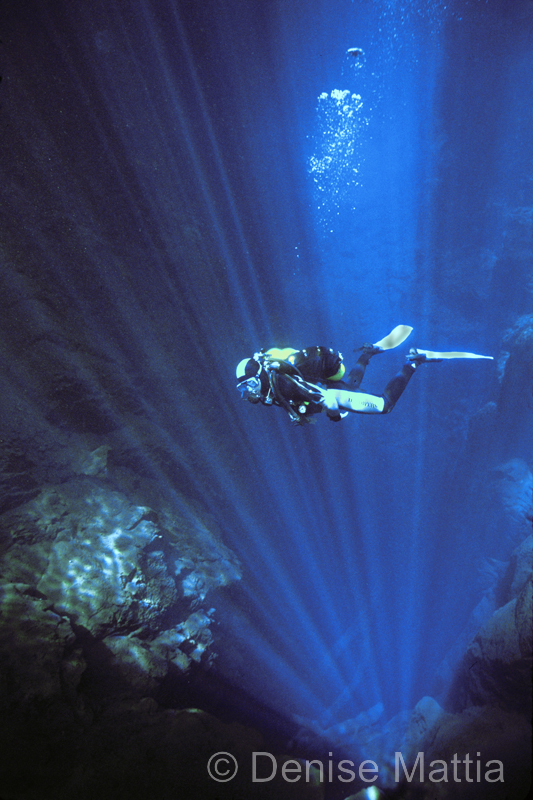
The morning was chilly when I eased off a platform at the edge of the embankment into crystal-clear 60˚ water, grateful for my five-mil wetsuit. On either side of the shallow river at Rio Formoso, tall reeds, bowing to the current, hid schools of firetail and neon cardinalfish. Tiny crabs scurried into gnarled tree roots when I approached. A scattering of snails dotted algae-coated hardwood stumps like confetti; a river turtle blew bubbles at me, about-faced and scooted for the surface.
Ismael led me upstream and over slabs of smooth rock to where the river emerges as a waterfall. My vision was obliterated by froth caused from the overhead cascade of water. The fizz felt like I was submerged in a bowl of champagne. Leaving the bubbly behind, I drifted back to the platform, giddy to be diving at last.
I was fully alert the following day as I picked my way down the gravely slope of a sinkhole with gear and camera equipment. Yet when I sank beneath the water and swam into the gaping opening of Gruta Mimoso, my imagination soared. I was swimming into the mouth of a gigantic griffin that had been chiseled out of the mountain by a madman. Above me hung rock teeth that could crush intruders in an instant. Beyond lay its gullet, dark and foreboding. Following the safety line slowly, Ismael and I penetrated 1,000 feet before turning into a chamber. In front of us loomed a field of enormous phallic-shaped mounds rising 50 feet from the floor and spanning ten feet in diameter. (The creator had had a sense of humor.) Beyond the room of cones, as these shapes, unique to Brazil, 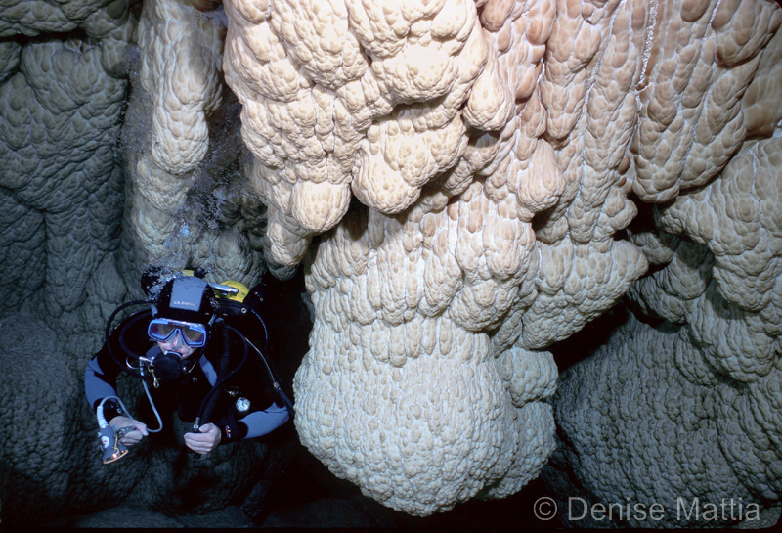 are politely called, rippling armor lined the beast’s spine and cauliflower formations bulged from its skeleton. When I suddenly recoiled from Ismael’s light tap to signal our return, I knew it was time to stop personifying a cave, fantastic though it was. There would be no further conjuring grotesque fiends on this journey.
are politely called, rippling armor lined the beast’s spine and cauliflower formations bulged from its skeleton. When I suddenly recoiled from Ismael’s light tap to signal our return, I knew it was time to stop personifying a cave, fantastic though it was. There would be no further conjuring grotesque fiends on this journey.
It was exhilarating to look 240 feet into a pit located on a hillside in the neighboring town of Jardim. The next morning we were trussed up, harnessed in and checked out by experts from SerrAventura before rappelling into Abismo An Humas, a feat that proved to be easier and more enjoyable than I had imagined. Ismael’s assistants, Sergio Aita and Hugo Kelm, and a small group of visitors descended two at a time to a wooden dock, where we retrieved and organized our equipment. My eyes adjusted to the dim light that filtered from the narrow passageway far above, revealing an oval-shaped room lined with enormous rock waterfalls and amphitheaters of calcified stone rising out of the water. To give us a closer view of the formations, Bruno Perdigao, a property-owner/employee who monitors safety procedures and ensures the preservation of the cave, reclaimed his inflatable and rowed us across this amazing 180-foot-wide underground well that reaches depths of over 200 feet.
Below, the 63˚ temperature numbed my face and hands. This eerie underwater wilderness was devoid of life, save for the bones of a few animals that had haplessly fallen here. Diving to 60 feet, our lights revealed wide cavities bulging with gothic pillars and lofty eaves curtained by stalactites and stalagmites. Perfectly shaped calcite cones – there are hundreds of them – protrude from the floor, their surfaces layered with the hardened primordial ooze that created them. I circled the cavern once more, finally leaving the forms fading behind me as I returned to the wooden platform. The lengthy process of packing equipment and transporting it to ground level had already begun.
While hauling myself upward, I passed formations that I had hardly noticed when shimmying down, and finally squeezed myself through the small crack in the ground. The entire adventure lasted five hours, and I emerged into the light and warmth of the sun having great appreciation for the display nature had created – and the life of a mole as well.
Between photographing monkeys, crocodiles and fish at the Eco-reserve in Rio da Prata, I dived Lagoa Misteriosa, a sinkhole mattress-thick with the soft sediment of decayed vegetation that billowed out if touched. Yet just as I got acclimated to the chilly calcium-rich mineral water (which has a monstrous effect if ingested in 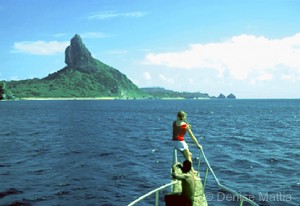 quantity), it was time to depart. I flew northeast to the archipelago of Fernando de Noronha, where a salt-water fix was on my agenda.
quantity), it was time to depart. I flew northeast to the archipelago of Fernando de Noronha, where a salt-water fix was on my agenda.
A Pernambuco state preserve under the auspices of IBAMA (Brazil’s national agency for the environment), the archipelago of Fernando de Noronha is renowned among divers in South America for the marine life found at reefs surrounding the 21 islands, which lie off Brazil’s northeast coast.
Of all the islands in the archipelago, only the largest (it 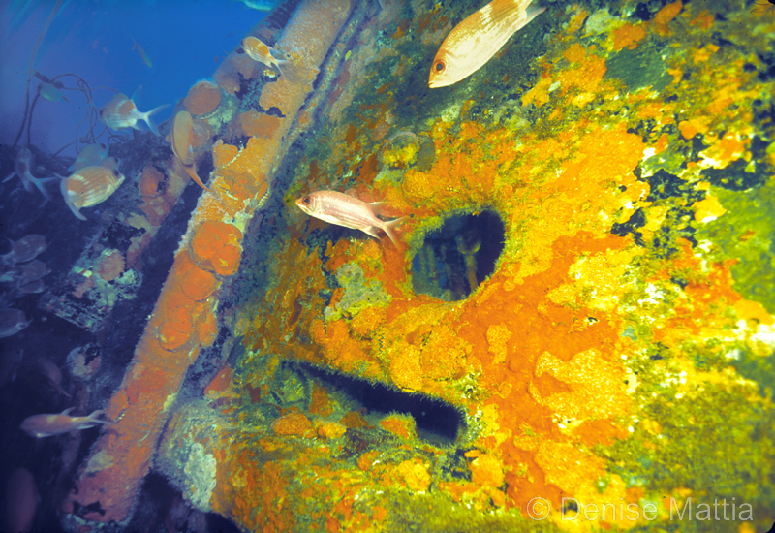 bears the same name as the archipelago) is inhabited. Climbing from the 18th century village of dos Remédios to the Forte, which long ago protected Fernando de Noronha from marauders, I was awed by the 360-degree panoramic view. Stunning, deserted beaches, reportedly the best in Brazil, lay below. The only buildings that dot the landscape are colonial government houses, convenience stores and residences with rooms to let. Beyond, verdant mountaintops rise from the emerald sea and appear as virgin as when they were first formed millennia ago.
bears the same name as the archipelago) is inhabited. Climbing from the 18th century village of dos Remédios to the Forte, which long ago protected Fernando de Noronha from marauders, I was awed by the 360-degree panoramic view. Stunning, deserted beaches, reportedly the best in Brazil, lay below. The only buildings that dot the landscape are colonial government houses, convenience stores and residences with rooms to let. Beyond, verdant mountaintops rise from the emerald sea and appear as virgin as when they were first formed millennia ago.
Three busy operations (Atlantis Divers, Aqua Clara and Noronha Divers) offer daily dive excursions to the southern (windward) side of the archipelago during summer when prevailing winds are fairly calm and to the tranquil leeward side in winter. I found that the background for dive sites here is the same as throughout most of the coastline of Brazil – grass-covered slopes and a veneer of reef organisms protruding from volcanic rocks – a heaven for large schools of fish, octopus, moray eels and nurse sharks. I spent nearly every dive chasing eagle rays, and lost count of the stingrays half buried in the sand. Mantas make an occasional appearance; on calm days you can catch a glimpse of them gliding beneath the surface of the water . . .if you’re lucky. If you’re really lucky, you can encounter spinner dolphins as well. Their permanent home is in the Bay of Golfinhos, but IBAMA has placed that area out of bounds for divers.
From December through May green turtles return to the archipelago’s beaches to lay their eggs and mate before heading back out to sea. It wasn’t the season for green turtles, but, since other varieties often visit Fernando de Noronha in search of food, I saw more hawksbills than anywhere else I’d been to date. Five of the world’s seven species of turtles are found in Brazil, and Project TAMAR/IBAMA (The Center for Conservation and Care of 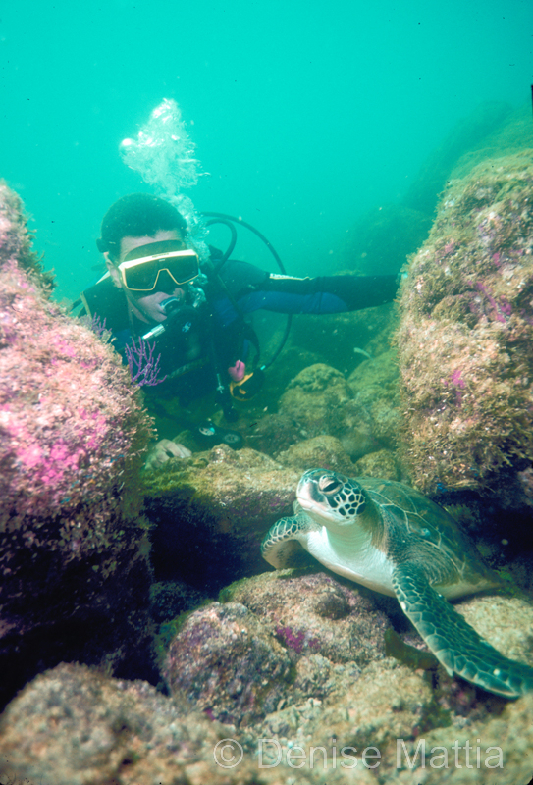 Turtles) works to protect them all.
Turtles) works to protect them all.
A week later I traveled south to Costa do Sauípe, an area known only to fishermen until four hotel conglomerates acquired the property and opened multistar resorts there in October 2000. After having stayed in efficient yet rustic accommodations in Bonito and Fernando de Noronha, I reveled in the comforts of first-class resort life at the SuperClubs Breezes. As the sun dipped lower in the horizon, guests followed the samba rhythms from the pool to the cocktail lounge, while I kept my date with a sauna as appropriate preparation for a Japanese dinner.
Sometime between heavenly prawns and nighttime at the piano bar I walked to the top of a dune at the edge of the property. Like a repeat pattern in a cosmic textile, tufts of clouds hovering just beyond my reach filled the sky and shone laser bright from the moonlight, which lay upon the dancing sea. Citrine-colored sand sparkled when touched by rolling waves. I knew I wouldn’t be happy following a path of sloth.
The next morning I was full of enthusiasm about diving. Within a couple of hours a scuba excursion for me was arranged in Salvador, Bahia’s capital, 45 miles to the south. I was to leave for the Bay of All Saints the next day if conditions for diving were suitable.
But this was August, winter in Brazil, when high winds and storms in the Atlantic stir the sandy bottom along the coast. Word reached me by late afternoon that visibility resembled face powder in a Mixmaster. Additionally, small craft were prohibited from leaving the marina. I discussed an alternate plan with Karen, the resort’s representative in charge of guest relations.
Brazil-born Laurent Lefebvre, whose 20 years of experience in white-water rafting have yielded several awards in Latin American competitions, assigned me to his inflatable canoe. Although I’d never shot rapids before, riding 25 miles down the Sauípe River (dry weather conditions have downgraded it from a Class IV to a Class II) didn’t seem to be any more difficult than scuba diving from a sit-on-top kayak in a choppy sea. My companions, two young men from Spain, and their guide were in another. We boarded the neon blue-and-yellow canoes at a serene inlet and fell into the rhythm of paddling.
I heard the first rapid before seeing it. “Back,” Laurent called from his rear position. I paddled backward. “Now forward.” I paddled hard, and we moved through the whitecaps. I got it. This sport is about not flipping or getting tossed out. Paddling backward acts like a rudder to keep the canoe in a head-on position, while paddling forward (fast) creates the momentum you need to move through the rush of white water. Eyes glued to the river ahead, I navigated between the whitecaps, which looked like little mountain peaks, and the impossibly black shiny bedrock. With every bounce, twist and maneuver downstream, I heard Laurent’s commands above the river’s sounds – calm, strong, and reassuring – which I followed as if my life depended upon them. Three more rapids were taken without dumping and after each Laurent showed me a place to stop and photograph my companions who followed behind (sometimes reversed) splashing, laughing and finally falling into the river. Still, my adrenaline pumped overtime when we approached a waterfall. By diehard standards this wasn’t more than a bump. From my perspective, though, approaching a smooth curl over which water was flowing warranted an expletive.
We swooshed down and spun sideways, landing wedged between rocks. Water was gushing around us, on us. Having nearly capsized once while diving from an inflatable that took a wave on its side, I know this position is not good. Refusing to be jettisoned, I pushed my paddle against the barrier, freed the canoe and rowed through froth, paddling with all my might. I was soaked, elated and considered pursuing this activity in earnest.
In comparison to the white-water experience, the subsequent trek-through-mud-and-paddle-a-canoe tour through the mangroves of the Sauípe River was tame, yet informative if you’ve never seen mangroves. More to my liking was a long, long hike up (and down) the steep cobbled streets of Salvador. The city’s landmarks, rich in color and exquisitely detailed, span a period from the 16th to the 19th Centuries, and are impossible to cover in one day. I spent my final morning touring the Project TAMAR/IBAMA conservation station in Praia do Forte. My next stop was the Abrolhos Archipelago preserve 350 miles south of Salvador.
I arrived at the port town of Caravelas just in time to board a three-day humpback whale watch and scuba 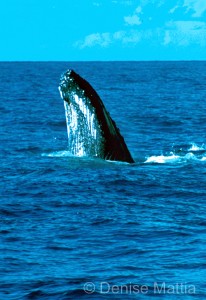 expedition bound for Abrolhos National Marine Park. Jean Pierre, captain and owner of the spiffy, ten-guest live-aboard called Catamarã had told us that with luck we’d see them.
expedition bound for Abrolhos National Marine Park. Jean Pierre, captain and owner of the spiffy, ten-guest live-aboard called Catamarã had told us that with luck we’d see them.
We weren’t at sea for more than a couple of hours when a quartet of humpbacks appeared far to port, spiraling into the air, splashing, tail-spinning into the water and disappearing again as we approached. Engines cut, all aboard scanned the horizon in utter silence. Suddenly there was a thunderous whoosh and an eruption of spray as one giant emerged aft, cruised beside the boat, rolled sideways for a better look and was gone. We were speechless, and all Jean Pierre could say over and over was, “Lucky.”
The warm, north-to-south Brazilian Current that brings humpbacks to breed and mate at the banks of the archipelago from July to November carries with it runoff from coastal rivers, which decreases visibility. The current also transports Caribbean marine life to the reef, and a permanent population is well established here. Porkfish, tuna, grunts and grouper were plentiful at sites where we were allowed to dive.
Coral and sponge grow in wild profusion on the wreck of the Naufrágio Rosalinda, a cargo boat that rammed into the reef and sank in 1939. Although the wreck’s bow is embedded in sand at 76 feet, her deck, companionways and stern stand close to the surface. The fish life here was plentiful and included moray eels, their movements appearing almost as in slow motion as they retreated reluctantly into their lairs. I could have returned home content after this expedition, but I would dive in Rio de Janeiro come hell or high water.
I got exactly that in the form of three-foot swells off the coast of Buzios, a charming village north of Rio City. I danced the samba to time a wave at the site Armaçáo dos Buzios and dived into water that was green with algae. Below, gigantic stingrays glided above the sand. Huge starfish and translucent grass anemones clung to bare rock. Kupeu, owner of Casamar Dive, found a green turtle between boulders, a sharptail and a spotted snake eel, and a harlequin pipefish.
Shipwrecks – there are dozens of them – are adorned with lush fronds of soft coral farther to the south at Arraial do Cabo. From July to March, the cold Resurgence Current from Patagonia carries polyps that take hold and grow profusely on rocks and wrecks, and nutrients that attract whales, crustaceans and fish. The results are pelagics on stunning reefs, but at a high cost of visibility. Still, Paulo Lopes of PL Divers and Sanderson of Arraial Sub Diving Center had no trouble guiding groups of diehard divers to the multicolored jewels.
Wet gear packed, my last stop was Araruama Bay to watch Marcelo Cunha, Brazil’s #1 kite surfer, perform thrilling stunts in the strong wind. The conditions that were ideal for him had prevented me from diving the coral formations in Rio’s Angra dos Res, the shipwrecks in Salvador’s bay and the reefs at Recife. In general, spring and summer (our fall and winter) are more favorable seasons in which to dive in Brazil. Still, I had experienced five weeks of water sports in the largest country in South America, and that suited Senhora just fine obrigado very much, indeed.
# # #
Note: Brazil’s excellent infrastructure allows easy access to most destinations throughout the country, but its sheer size and the location of its cities and sites make it a difficult country to see rapidly. Consider flying from site to site if your time to experience Brazil is limited.
City of Rio Hotels:
Mid-priced hotels include Luxor Regente, Av. Atlantica, 3716. Phone (021) 523-4121, fax (021) 267-7693. Winsor Palace, Rua Domingos Ferreira, 6. Phone (021) 548-0098, fax (021) 549-9373.
Hotel El Cazar, Alto do Humaita, 6 Armacao, Buzios, RJ. Telefax (024) 623-1620
Arraial do Cabo Diving/Pousadas & Hotels:
PL Divers, Paulo Lopes owner. Rua Nilo Pecanha 57 – Praia dos Anjos, Arraial do Cabo, RJ., CEP 28830000. Phone (24)-2622-1033, (24)-2622-1093, (24)- 9818-0650. Email Pldivers@pldivers.com.br, plopes@ pldivers.com.br plcursos@pldivers.com.br
Sand’Mar Nautica, Sanderson, owner. Av. Getulio Vargas, 213-A, Arraial do Cabo., RJ. Phone/Fax (24) 622-1356. www.mar.com.br/sandmar Email sandmar@mar.com.br
Hotel Praia dos Anjos, Av. Roberto Silveira, 10 – Praia dos Anjos, RJ 28930-000. Telefax (24) 622-1378, Central de Reservas RJ: (21) 522-1098, 521-8297 fax (21) 521-7946. Email praiadosanjos@uol.com.br
Fernando de Noronha (Pernambuco):
Head of the Ecotourism Department:Phone (55-81) 3619-1378 and phone/fax (55-81) 3619-1352.msereno@noronha.pe.gov.br
Atlantis Divers, Patrick Muller, owner. Caixa Postal 20, Fernando de Noronha – PE Brazil CEP 53990-000. Reservations (84) 206-8840/41. Phone (81) 3619-1371. www.atlantisnoronha.com.br Email info@atlantisnoronha.com.br
Noronha Divers. Terminal Turistico do Cacmorro – Sin – Vila dos Remedios, Fernando de Noronha – Pe. CEP 53990-000. Phone (81) 3619-1112, fax (81) 3619-1485
Costa do Saiupe (Bahia):
Bahiatursa has an office near the arrivals gate at the airport in Salvador. Their representatives speak English fluently. Tel. 011-55-71-370-8400, Fax + 371-0110
SuperClubs Breezes (Costa do Sauípe). Visit their Web page at www.superclubs.com or contact Xavier Veciana, Director of Operations, Caixa Postal 7336 Cep 41811-970011, Salvador BA, Brazil, tel. 55 71 463-1502, fax + 463-1506. Upon registering at the SuperClubs Breezes, you are assigned a guest relations representative to assist with resort-related issues and with tours. Bahia Adventure has a branch at the village in Sauípe. Contact Beto Dias, tel. 011-55 71 464-2525, fax.+ 464-2526.
Salvador:
Sofitel Hotel. Philippe Godefroit, General Manager. Rua Passargada, S/N, Itapua, Salvador, BA. Phone (71) 374-8500, fax (71) 374-6946. Reservations 0800-703-7003. www.accorhotels.com.br
Off the Beaten Track (Bahia):
Liveaboard Excursion to the Abrolhos Archipelago
Horizonte Aberto, Catamara. A catamaran beautifully designed by owner/captain/diver Jean Pierre and his wife Jacqueline. No email, no website. Rua Anibal Benevolo, 549 Centro Caravelas – BA. CEP 45.900-000. Phone (73) 297-1474, (73) 674-1060.
Electricity: Mostly 220. In some areas, 110 60v.
Language: Portuguese, Spanish and in many areas, English.
About Denise Mattia
A writer and photographer, Denise Mattia’s works are published nationally and internationally and include all aspects of leisure travel: art , culture, resorts, spas, food and wine and sports’ activities. She's the founder of the soon to be launched Yum-Yum-Traveler, a site devoted to reviewing restaurants in addition to her travel articles from around the world. She lives and works in Manhattan, where she was born.
- Web |
- More Posts (91)
